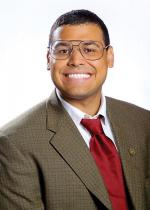Finding Connections: SPS Student Recognized for Photonics Research and Leadership
Spring
2017
Singularities - Profiles in Physics
Finding Connections: SPS Student Recognized for Photonics Research and Leadership
Nick Rivera, SPS Member, Massachusetts Institute of Technology and Kendra Redmond, Contributing Writer
Massachusetts Institute of Technology
 The American Physical Society’s LeRoy Apker Award recognizes outstanding achievements in physics by undergraduate students and provides encouragement to young physicists who have demonstrated great potential for future scientific accomplishment. The 2016 recipients are Stephanie Gorczyca from the University of San Diego and Nick Rivera from Massachusetts Institute of Technology (MIT).
The American Physical Society’s LeRoy Apker Award recognizes outstanding achievements in physics by undergraduate students and provides encouragement to young physicists who have demonstrated great potential for future scientific accomplishment. The 2016 recipients are Stephanie Gorczyca from the University of San Diego and Nick Rivera from Massachusetts Institute of Technology (MIT).
Below, we hear from SPS member Nick Rivera on his research, SPS involvement, and what this award means to him. His Apker Award citation reads: "For important advances in the field of photonics and exceptional leadership of the Society of Physics Students."
What happens when excited atoms interact with the quantum vacuum fluctuations of electromagnetic fields of 2D conductors (like graphene)?
This was the focus of my undergraduate thesis work at MIT. The short answer: Potentially, a lot.
Spontaneous emission processes in atoms that normally take billions of years to happen could potentially take place in billionths of a second when an atom is placed a few nanometers away from the surface of graphene. Such a spontaneous emission process has not been observed, but my work suggests a general recipe for accessing these kinds of rare processes, possibly providing a spectroscopy platform that could access a much more detailed optical fingerprint of any atom or molecule. I was the first author of a paper on this research that was featured in the journal Science in July 2016 (DOI: 10.1126/science.aaf6308), and it was the subject of my Apker Award presentation.
I am now a first-year physics PhD student at MIT working under Prof. Marin Soljacic on problems in light-matter interaction and nanophotonics. This research flowed naturally from my undergraduate research and can be divided into two basic goals. The first is enabling, accessing, and controlling conventionally forbidden atom-photon interactions. The second is studying fundamental electron-photon interactions in order to find new ways to generate high-frequency light on the nanoscale and to enhance quantum mechanical effects in electron-photon interactions.
What unifies these two parts is analysis through the tools of classical and quantum electrodynamics and through the lens of nanophotonics, the science of controlling the properties of photons on the nanometer scale. More generally, my interest is in taking tools from what is normally considered “theoretical” physics and using them to analyze problems of a more applied nature.
As the vice president and president of my local SPS chapter, I aimed to bring student research to the forefront. To that end, I introduced a new event called SCUPH (Student Colloquia in Undergraduate Physics), where undergraduates give research talks that are open for anyone to attend. My hope in developing this event is that undergraduate physics students will be exposed to approaches to physics beyond what they are familiar with from their own research.
Receiving the Apker Award was a great honor. I am grateful for not only the physics contributions of my collaborators, but also the mentorship and attention I received from the graduate students, postdocs, and faculty that I worked with. They ultimately shaped my thinking on how to approach physics and challenged me to be creative and imaginative. Because of them, I identify the fun in physics research as the process of finding new connections between seemingly unrelated physical ideas.
For more information on the LeRoy Apker Award, visit the APS website.
